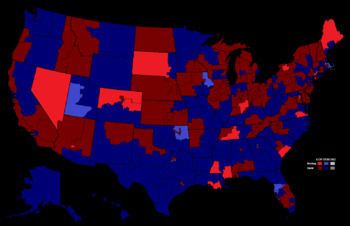November 7, 1972 1974 → 242 192 37,071,352 33,119,664 Start date January 7, 1972 | 255 seats 180 seats 13 12 52.1% 46.5% | |
 | ||
Winner Carl Albert | ||
The 1972 United States House of Representatives elections was an election for the United States House of Representatives in 1972 which coincided with the landslide reelection victory of President Richard Nixon. Nixon's Republican Party managed to gain a net of twelve seats from the Democratic Party, although the Democrats retained a majority. This was the first election that citizens at least 18 years of age (instead of 21 and older) could vote due to the recent passage of the 26th Amendment.
Contents
Summary of results
Source: "Election Statistics". Office of the Clerk.
Democratic gains
Democratic holds
Republican gains
Republican holds
Incumbents defeated in primary
- California's 8th congressional district: George P. Miller (D)
- California's 39th congressional district: John G. Schmitz (R)
- Colorado's 4th congressional district: Wayne Aspinall (D)
- Georgia's 1st congressional district: George Elliott Hagan (D)
- Michigan's 19th congressional district: Jack H. McDonald (R)
- Nevada's at-large congressional district: Walter S. Baring, Jr. (D)
- New Jersey's 13th congressional district: Cornelius Edward Gallagher (D)
- New York's 18th congressional district: Emanuel Celler (D)
- New York's 22nd congressional district: James H. Scheuer (D)
- Pennsylvania's 3rd congressional district: James A. Byrne (D)
- Pennsylvania's 22nd congressional district: William Sheldrick Conover (R)
- South Carolina's 6th congressional district: John L. McMillan (D)
- West Virginia's 4th congressional district: James Kee (D)
Incumbents defeated in general election
- Colorado's 1st congressional district: Mike McKevitt (R)
- Connecticut's 5th congressional district: John S. Monagan (D)
- Illinois's 10th congressional district: Abner J. Mikva (D)
- Indiana's 11th congressional district: Andrew Jacobs, Jr. (D)
- Iowa's 1st congressional district: Fred Schwengel (R)
- Iowa's 4th congressional district: John Henry Kyl (R)
- Massachusetts's 9th congressional district: Louise Day Hicks (D)
- New York's 26th congressional district: John G. Dow (D)
- Tennessee's 6th congressional district: William Anderson (D)
- Texas's 5th congressional district: Earle Cabell (D)
- Texas's 13th congressional district: Graham B. Purcell, Jr. (D)
- Utah's 2nd congressional district: Sherman P. Lloyd (R)
- Wisconsin's 7th congressional district: Alvin E. O'Konski (R)
Separate elections
Some special elections were held on days other than the November election.
Alabama
Alabama was reapportioned from 8 to 7 seats and eliminated the old 3rd district, dividing it between the old 2nd and 4th and making compensating boundary changes elsewhere.
Alaska
Incumbent Nick Begich won re-election three weeks after having disappeared in a plane crash October 16; challenger Don Young would later win a March special election after Begich was declared dead on December 29.
Arizona
Arizona was reapportioned from 3 seats to 4 and carved a new district in the Phoenix suburbs and the northeast from parts of the existing districts.
California
California was reapportioned from 38 to 43 seats, adding one seat in the Bay Area, one in the Central Valley, and 3 in southern California; three went to Democrats, two to Republicans. Despite a retirement and two lost renominations, both parties held their seats in this election, bringing the Democrats up from 20 seats to 23 and the Republicans up from 18 seats to 20.
Colorado
Colorado was reapportioned from 4 to 5 seats, constructing a new 5th district east and south of Denver.
Florida
Florida was reapportioned from 12 to 15 seats, adding a seat in central and two in south Florida.
Iowa
Iowa was reapportioned from 7 seats to 6, dividing the old 5th district around Des Moines between its neighbors. Its incumbent, Neal Smith, won again in the south-central Iowa 4th district.
Louisiana
Louisiana stayed at eight house seats following the 1970 census, but the Eighth District's boundaries were radically altered. New governor Edwin W. Edwardsordered the district to take in territory far to the south and east of its traditional base of Alexandria, which included many African-American and progressive white voters. The change was largely regarded as an election deal between Edwards and former Rep. Gillis Long, who finished third in the Democratic Primary in the 1971 Louisiana Governor's Election. Long easily won back the Eighth District seat he lost in 1964.
Maryland
Maryland’s redistricting eliminated a seat in Baltimore in favor of an additional seat in the DC suburbs.
